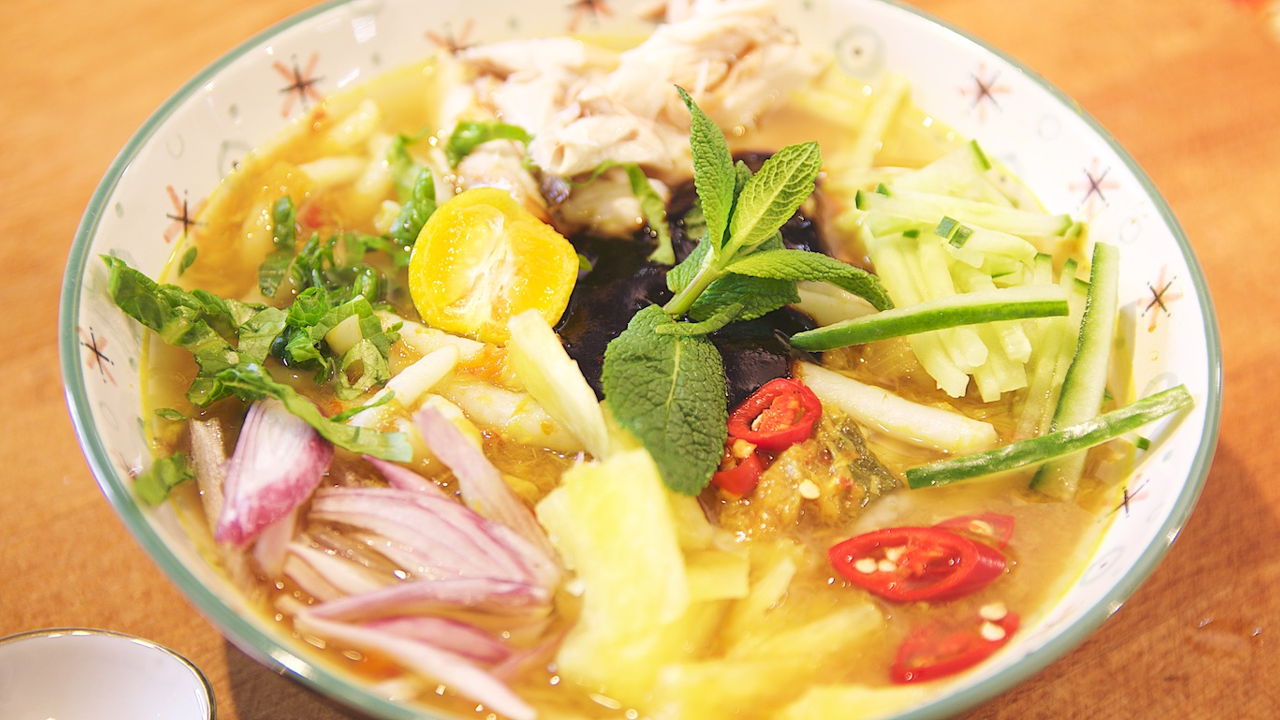Asam laksa is a soup rice noodle dish. The flavours are bold with sour and savoury nodes, contributed by tamarind and a tasty fish broth. The after taste is a hint of spiciness. Each spoonful has a complex but balance flavour. Just enough tanginess to perk the appetite, umami to get you wanting for more and spiciness to wake those taste buds. The bunch of fresh herbs added to it makes the dish even healthier.
In fact, the meaning of the word ‘asam’ in Malay is ‘sour’, the simplest word to describe the dish. Food explorer guru Anthony Bourdain loves this sour and spicy noodle dish. He claimed that he never fails to have it each time he travels to Penang. It was in Penang, where many flock to the Ayer Itam/Air Itam wet market to get a taste of the famous Asam laksa.
Why this Asam Laksa recipe?
Easy and tastes like the real deal! This recipe sections the process into understandable steps which you can make and prepare in advance. The taste of this soup is really good because of the ingredients proportion. Too much tamarind, it will be too sour. If the amount of spices are not done balanced, it might leave a bitter after taste. Most importantly, I made sure that this recipe did not create a fishy broth. It’s something I personally dislike! The final result is guaranteed perfect!
Secret Asam Laksa paste
The paste is made of dried chillies, shrimp paste, turmeric, galangal, shallots and lemon grass. If you are lucky enough to find the fresh herbs, that would give out the best taste. Otherwise, opt for frozen herbs. Shrimp paste is a must have when preparing the paste as explained in step 2. So, don’t miss that out!
Type of fish used in Asam Laksa
In this recipe, Spanish mackerels are used as the base of the broth. In Malaysia, Indian mackerel (ikan kembung) is the more popular option. Besides mackerels, sardines or skip jack tuna (ikan tongkol) may be used too. We've had some in the community who use canned tuna or sardines. It’s a short cut but seem to work really well too! You can see the feedback in the food snaps.
How to prevent ‘fishy’ broth?
Using fresh fish is the key to prevent the broth from having an unpleasant fishy smell. As a guide, ensure that the eyes of the fish are clear and the gills are bright red when choosing fish. Just a reminder, though. Be sure to remove the bones thoroughly after boiling the fish.
Another tip is to marinade the fish with tamarind juice (tamarind paste mixed with water) or lemon juice for 20 minutes in the refrigerator. Then, rinse the fish thoroughly. I didn’t do this step because I used the fish on the same day I bought it. You might not want to skip this step if you are very sensitive towards the fishy odor.
Lastly, always add enough laksa leaves or Vietnamese coariander leaves. They help in reducing the fishy smell, if any.
Substitutes for ingredients
The asam laksa broth is uniquely sour because of two ingredients - 'asam gelugor' and tamarind paste. However, out of Southeast Asia, asam gelugor may not be available. Therefore, add more tamarind paste to create the sourish taste in asam laksa.
The other special ingredient which is tough to find is ginger torch flower. Usually, they are sold at the markets. Just skip this ingredient if you are unable to find it.
Type of noodles used in asam laksa
Asam laksa uses very thick rice noodles which are not easily found out of Malaysia or Singapore. Therefore, make them using the recipe here. Otherwise, udon noodles are a great substitute. Although made using wheat flour, they are thick and tender just like those used in asam laksa.
With so many tantalizing flavours coming together, this dish is a definite delight to savour. The smoothness of the noodles, small pieces of fish, shrimp paste, fresh shallots, cucumber, pineapple slices and the slightly spicy sourish soup just complement each other so well. The soup will surely tease your taste buds and stirs up your appetite with every mouthful. Of course, it is such a pretty dish too!
